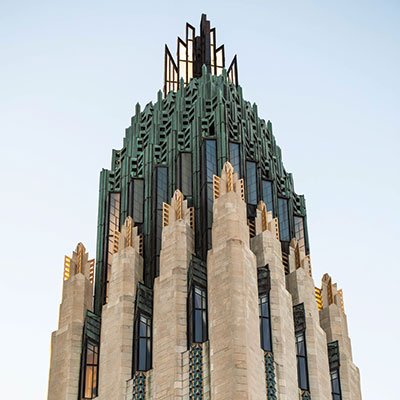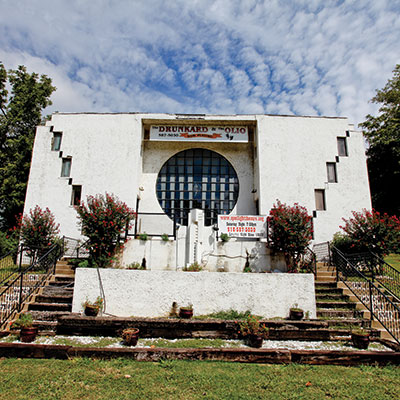Leave a mark
How Bruce Goff modernized Tulsa
Architect Bruce Goff designed Boston Avenue Methodist Church at 22 years old, sharing design credit with his former high school art teacher Adah Robinson.
VALERIE WEI-HAAS
In her debut feature documentary GOFF, Oklahoma filmmaker Britni Harris sets out across the country to answer a vital question about the work of architect Bruce Goff: How does a city “live with the past and present in one continuous stream”?
The answer to the architect’s animating question can be found right here in Tulsa, where Goff represents the connective tissue between the city’s early and modern periods. The crown jewel of Green Country, Tulsa became a sort of playground for the artist in the early 20th century, where the dramatic sweep of history and modernity lives in some of the architect’s most iconic buildings.
Goff’s family moved around Indian Territory during the turn-of-the-century, his father often unable to provide food for the family. In the pre-oil boom days of Tulsa, Henrietta, Hominy and Skiatook, Goff’s only exposure to architecture was the crude prairie structures erected in haste by white settlers and the more permanent but still recent dwellings of relocated Indians.
But as he grew older, Goff helped carve out another side to the same coin. The influx of oil money and a growing Tulsa population meant new structures were needed, and not simple things, but buildings that could put the city’s new money on display.
Goff began an apprenticeship at the architectural firm Rush, Endacott and Rush at the age of 12 in 1916, where he would make partner by 1929. Between these two points Goff designed his first house at 13 and would see his last Tulsa home built in 1930. Some of these have been destroyed to make way for luxury homes, others have seen major alterations, but many still stand in Goff’s unassuming residential Deco style.
 The first major work that would shape his career and his most well-known achievement is Boston Avenue Methodist Church. At 22 years old, sharing design credit with his former high school art teacher Adah Robinson, Goff’s virtuosic vision was expressed in what the National Register of Historic Places calls “the most current stylistic thinking of that time period of American architecture [with] few peers among its contemporaries.” The church rises south of downtown, as if setting itself apart from other Deco structures in a holy manner.
The first major work that would shape his career and his most well-known achievement is Boston Avenue Methodist Church. At 22 years old, sharing design credit with his former high school art teacher Adah Robinson, Goff’s virtuosic vision was expressed in what the National Register of Historic Places calls “the most current stylistic thinking of that time period of American architecture [with] few peers among its contemporaries.” The church rises south of downtown, as if setting itself apart from other Deco structures in a holy manner.
Goff then designed the Tulsa Club building one year later in 1927. Another downtown structure, this was a decadent boys club up top and housed the Tulsa Chamber of Commerce on the first five floors. Abandoned in 1994, the Tulsa Club fell into major disrepair. This might represent the tension between Tulsa’s rising history of wealth, fall, and an ongoing revival. Rather than bulldoze it for a parking lot, the Hilton Curio Collection took control of the property and converted it into an opulent 96-room hotel that opened its doors earlier this year.
 One can worship in a Goff, stay the night in a Goff, or see The Drunkard and the Olio at the Tulsa Spotlight Theater on Riverside, designed by Goff in 1929—but filling in the gaps requires some internet sleuthing, prowling midtown neighborhoods for other commercial and residential works, or venturing beyond the borders of Tulsa County.
One can worship in a Goff, stay the night in a Goff, or see The Drunkard and the Olio at the Tulsa Spotlight Theater on Riverside, designed by Goff in 1929—but filling in the gaps requires some internet sleuthing, prowling midtown neighborhoods for other commercial and residential works, or venturing beyond the borders of Tulsa County.
To help fill these gaps, GOFF filmmaker Harris spoke with homeowners and those who knew the architect on a road trip through his most productive regions. Setting off with a six-person crew from Kansas City to California, Harris and her team of Oklahoma filmmakers followed the architect’s footprint to answer his eternal question of fluidity in time and space.
“Honestly, that road trip gave me my voice as a filmmaker,” Harris told The Tulsa Voice upon returning in 2015. “Before that, I was very nervous to power through the story and really take a hold of it. But once we took the road trip, it was on my shoulders to keep us going and keep driving.”
The film made its premier in October at the Architecture & Design Film Festival in New York City, but its Tulsa premier is still forthcoming.
While Goff left a lasting mark on the city of Tulsa, he never designed another structure here after leaving town in 1930. It’s as if, responsible for Art Deco’s apex, Goff had left his mark and decided to move on. He saw Tulsa in its squalor and its riches. The skyline is better for it, and so are we, walking among the remnants of his dreams.


.jpg)
.jpg)
